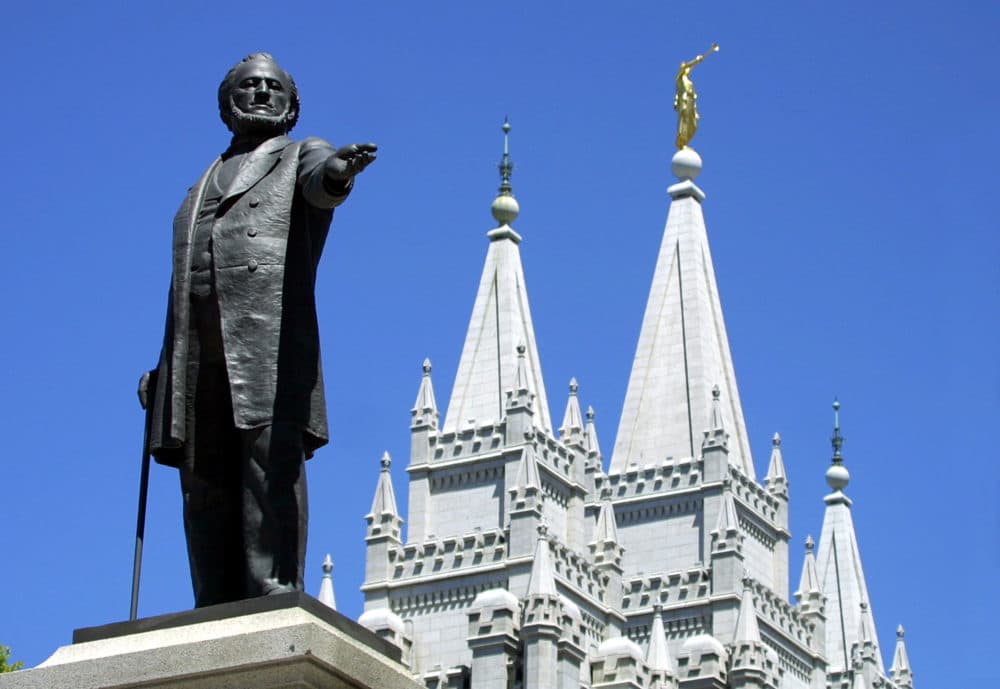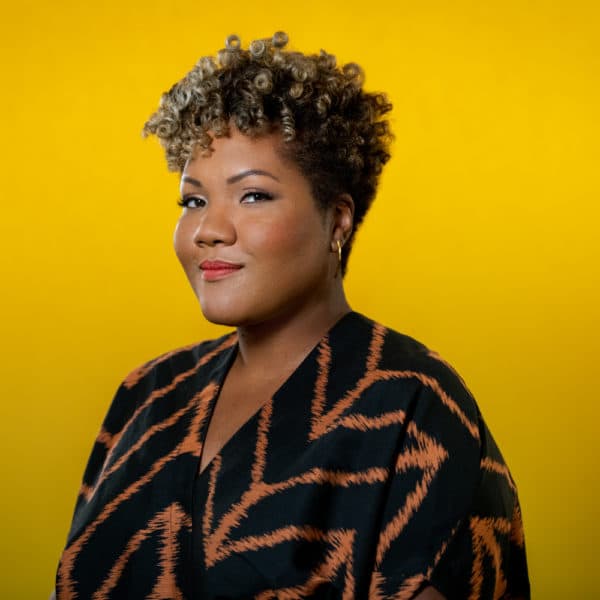Advertisement
Mormons Grapple With Church's History Of Discrimination Amid Wider Racial Reckoning

The Church of Jesus Christ of Latter-day Saints, whose members are also known as Mormons, has a troubled history with racial discrimination.
Black Americans were among its earliest converts and even served in leadership roles — but for over a century, they were barred from being ordained to the priesthood or from entering Mormon temples, where the faith’s holiest rituals are performed.
That position wasn't reversed until 1978.
Now that recent protests have forced a racial reckoning throughout American society, many Mormons are taking a renewed look at racism in their own faith.
The LDS Church announced an official partnership with the NAACP in 2018, but it may not be putting words into action, says LaShawn Williams, a licensed clinical social worker and an assistant professor of social work at Utah Valley University.
“I think that one of the best ways to show leadership is to do what you ask your members to do,” says Williams, who co-founded the Black LDS Legacy Committee, which puts on a yearly conference about Black Mormons. “And as a membership, we are told that whenever we harm our brother, you go and make good with your brother first and then you go off into the rest of the world.”
While some Mormons are a “little resistant” to anti-racist efforts by fellow church members, the majority are very open to it, says Diana Brown, co-founder of a study group on race and The Book of Mormon, one of the church’s scriptural texts, along with the Bible.
“I think a lot of them have questions as well about how to reconcile some complex aspects of the church history,” she says, “and how … they [can] maintain their faith and testimony in the church while acknowledging the pain that people of color experience due to certain policies and cultural norms and what to do about that.”
Advertisement
Interview Highlights
On the Mormon church's official partnership with the NAACP
LaShawn Williams: “I think it runs the risk of being a symbolic partnership as opposed to a practical partnership. [The church] offered, in the Medium piece where they initially spoke out for racial unity, that they would explore ways together to work together to improve self-reliance and upward … mobility for inner-city and minority families. And so one of the spokespeople for the NAACP said that those were minor efforts, and they don't befit the stature and magnitude of what the LDS church can and should do and how they were looking forward to the church doing more to undo the 150 years of damage they did and how they treated African Americans in the church.”
On whether the church should apologize for barring Black people from receiving the priesthood or entering Mormon temples
Williams: “I would love to see the church issue a number of statements. They came close. They released an essay that disavowed any previous practices, folklore, thoughts or ideas that were perpetrated by church leadership about the reasons for the ban. They did not go so far as to call the ban wrong or to call the ban racist. But they disavowed all of the explanations that were given and said that they currently disavow racism and that it is not connected to the gospel of Jesus Christ.”
On the origins of the Black LDS Legacy Conference, and on Black Mormon heritage
Williams: “The Black LDS Legacy Conference came from the broken hearts of Black women after the acquittal of George Zimmerman in 2013. … We were having interactions with other Black members, wondering, ‘Why is no one saying anything from the pulpit? How can we go to church on Sunday and it feels like we're the only ones who care about what's happening to Black people here in the U.S. in the wake of police brutality?’ And so we created the conference on Wakanda weekend, when Black Panther opened, to be able to say, ‘We have a place here. We've always had a place here. We'll continue to carve out space for our place.’
“A few Black members that are inspiring to us are ... first pioneers, the first people to be baptized into the church or the first ones to hold the priesthood, or the first one to join the Mormon Tabernacle Choir, or the first ones to be baptized outside of the United States, and we listed all of their names on a T-shirt to go along with so many of the other Black history pioneers, [Malcolm X] and [Martin Luther King Jr.] and me, and we took that same energy and applied it to the church experience for Black members in Black history in the LDS church, because holding onto ancestors, standing on the shoulders of giants, is what allows us to continue moving forward. And there's work to be done in every place where Black people set their feet.”
On her call to action for ward (local congregation) members
Williams: “For the ones who served a mission and it's international and they come back and say, ‘I really grew to love the people in this location’ — show me. When you come back from a place like continental Africa, you come back from Afro-Latino countries, you come back from the Caribbean and from the West Indies, do you translate that learning into your actions here back in the U.S.? Are you out marching and engaging in conversations for Black Lives Matter? Are you addressing structural, educational and employment inequalities in Black communities, or do you reserve your love for the people you served because you felt like they needed you and you had something to give? For my members in wards and congregations, you've got the privilege, you've got the power, and with great power comes great responsibility. And we need to be using it more to make reality, equality and freedom happen for others.”
On white Mormons’ reactions to anti-racist efforts by fellow church members
Diana Brown: “There is certainly a faction of people who I think are a little resistant to this, who see this as part of revisionist history, but I would say that the majority of people that I see are very, very open to it. We had everybody answer a quick question: Why do you want to take part in this? And I think what I find really remarkable is how I'm seeing people really seamlessly blend language that we're drawing from this anti-racist movement that, you know, is largely happening outside of our church, with rhetoric about personal change, ministering, building Zion, building community that's very common in the church. For the most part, I'm really not seeing those things come in conflict. I've seen people bring these two aspects of themselves, these two moral projects, so to speak, together into one place.”
On the conversations Brown’s group has facilitated
Brown: “We've brought different speakers and scholars to come based on either their professional or personal expertise in this topic, and so it ended up being a blend of, sort of, their scholarly work, personal experience and then … wherever the conversation goes from there.
"We’ve had Brother Ahmad Corbitt come. He's a first counselor in the General Young Men's Presidency for the church, so a pretty high leadership position. He also is African American. He sort of talked about his initial draw to the church and to the Book of Mormon as, to use his terms, the most racially unifying book of scripture out there. We had an Indigenous scholar, Farina King, come in and talk about a passage in the Book of Mormon that's often interpreted to be referring to [Christopher] Columbus, and she was just sort of raising the question: Are we wanting to glorify Columbus at the expense of our Indigenous members of the church?”
On the questions participants commonly ask
Brown: “The goal is to ... have it be like an academic Sunday school. This wasn't a fringe group of people who ended up coming to this … based on the comments that we were getting and the questions that we were receiving. These are people who are pretty central in the church and involved in church leadership and things like that, and I think their common questions are just wanting to really understand the perspectives of minorities and people of color in the church for pastoral reasons, wanting to know how to do better outreach [and] administering.”
On what drew her to co-organize the study group
Brown: “Growing up, I was taught to take the church very seriously, and I took very seriously this idea that there were all children of God and that everybody comes to Earth to grow and learn. And this idea that no human life and no human experience is wasted, that somehow all of this fits into the bigger story of how God is working with humanity. I've just always been a fan of being brave to take our doctrines really seriously and to go to the margins and really amplify those voices and to be thinking … more deeply and broadly about how we're all connected to each other and how … we absolutely need these stories, and they're all a part of us, and we just should not be afraid of them and should not be afraid of challenging our perspectives. If we're taking our most core doctrine seriously, we should be the most engaged in causes like this, not the least.”
On how the church can move forward in a more inclusive way
Brown: “I do think that people are really hungry for a theological reckoning with the church's past, something that is ... not just saying, … ‘Now we're all one, now that [the] policy is gone.’ Something that is saying, ‘How do we make sense of the fact that this happened?’ And … maybe there aren't answers to that. Maybe it's just more sitting with it. But I think that people are really wanting to lean into that space, and I feel like as a community, we need more spaces to hold that question together [with] whatever comes from it. And I think that's kind of what's necessary before we would be able to move on.”
James Perkins Mastromarino produced and edited this story for broadcast with Tinku Ray. Elie Levine adapted it for the web.
This segment aired on September 22, 2020.
